

I typically don't end up traveling very often for work. However, once or twice per year I'm fortunate enough to be sent to work conferences hosted by the American Medical Association (AMA). The January conferences hosted by the AMA always take place in some kind of warm weather locale, often in Florida or California or Arizona or something like that. The AMA has its headquarters in Chicago, and they host most of their work conferences there - but not the ones that take place in January for obvious reasons. No one wants to travel to Chicago in the middle of winter. In 2018, the AMA meeting took place at an inn and conference center located about 25 miles north of San Diego, California. These conferences that I attend are very much work trips, with the events starting at 7:00 AM most days and running until 6:00 PM. That doesn't leave much time to do anything beyond eat dinner and then head back to the hotel room. However, because the conference starts so early in the morning we always have to leave the day before it begins, and that leaves a little time to do some sightseeing on the day before the conference opens. I've taken advantage of this narrow window of free time on past work trips and I would take advantage of it again here.
My goal on this trip was a place known as the San Diego Zoo Safari Park. Owned and operated by the famous San Diego Zoo, this is a gigantic 1800 acre complex where the zoo can let hundreds of animals wander around freely in a natural environment. The climate of southern California is similar enough to eastern Africa that the animals can move about in a wilderness-like atmosphere. I had actually been here previously in 1993 when I was 10 years old, back when the place was known as the Wild Animal Park, and always wanted to return again as an adult. The biggest downside to visiting the Safari Park is the location: it's basically in the middle of nowhere, fully 30 miles outside of the city of San Diego. Fortunately, the inn and conference center where I was staying for my work trip was only about 5 miles away, and I had the afternoon free on this travel day before my work conference started the next day. I hired a Lyft driver to take me to the Safari Park and headed out to explore the area.
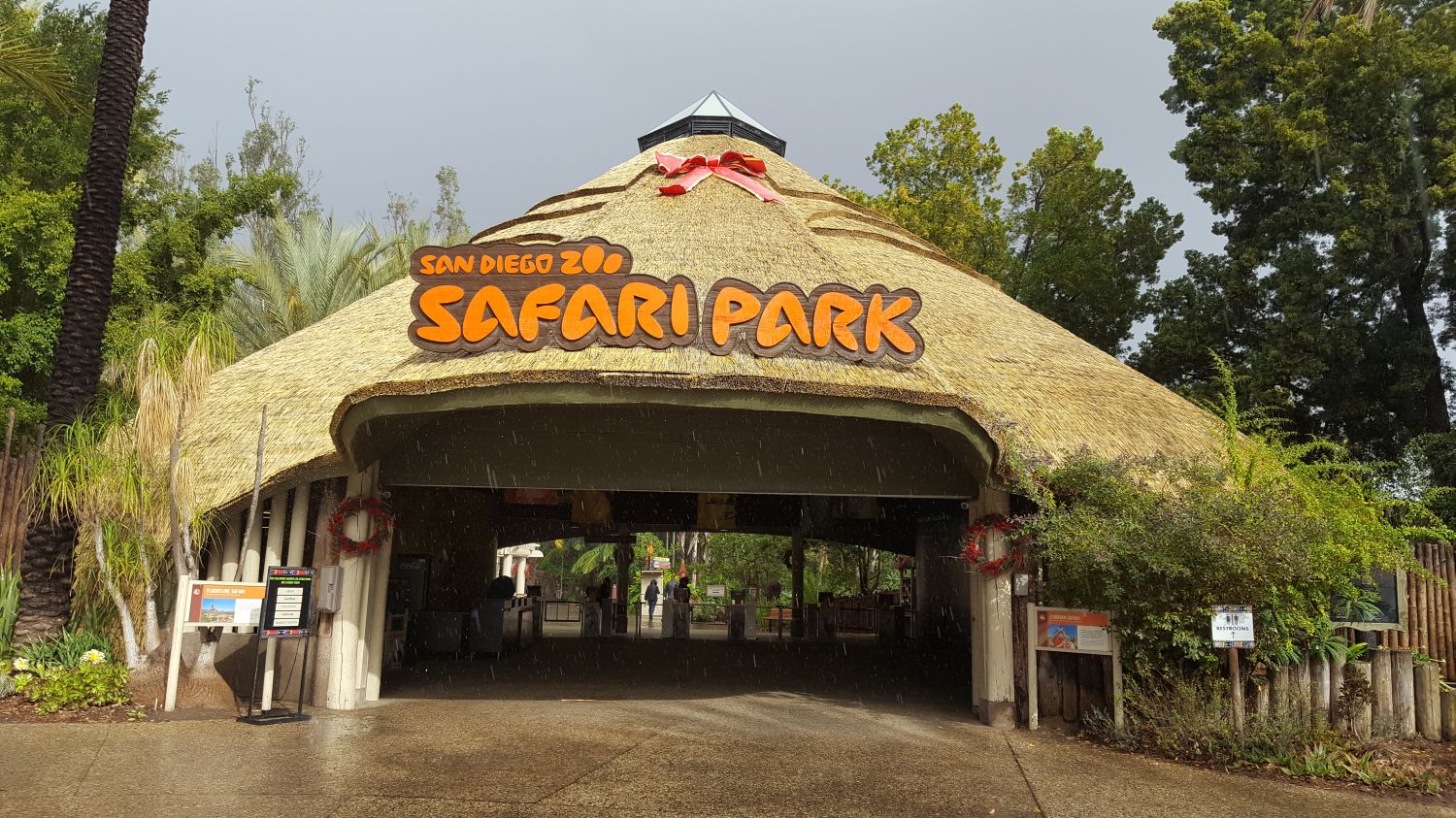
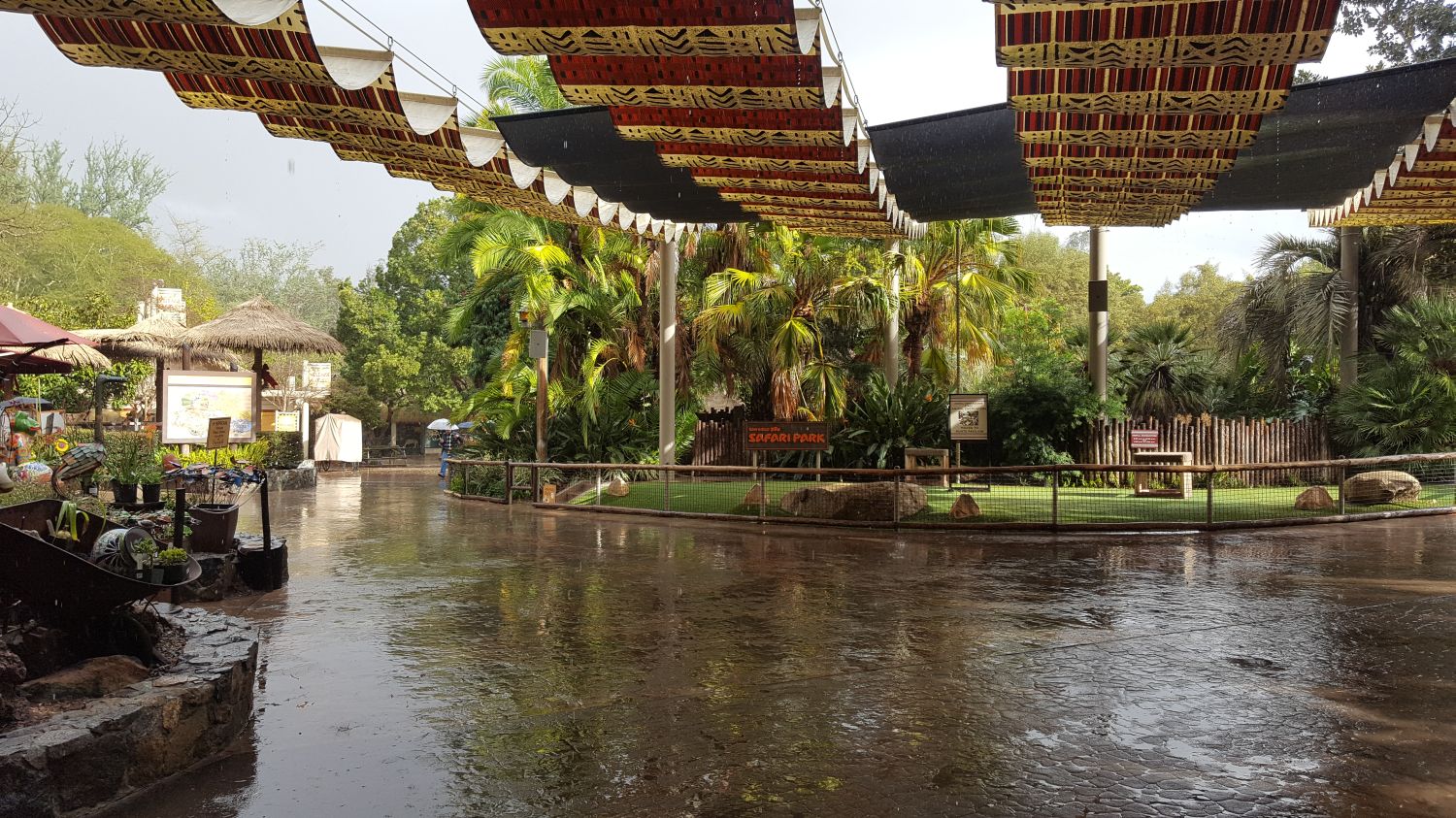
I had been checking the weather on the days leading up to this trip, and unfortunately the forecast was for showers throughout the afternoon in the San Diego area. That was extraordinarily unlucky, as all of the locals kept telling me that there had been no rain of any kind for the last three months. It figured: the one day that I had available to do some sightseeing was the one day that it would be raining. On the positive side, a rainy Tuesday afternoon in January meant that the Safari Park itself was deserted. I was arriving at about 2:00 PM (having taken a morning flight from Baltimore to San Diego) and the park would be closing a few hours later at 5:00 PM. The employees at the front desk actually asked me twice if I was sure that I wanted to pay the entrance fee. I did though, and once inside I started wandering around the empty and soaking wet pathways between the animal enclosures.

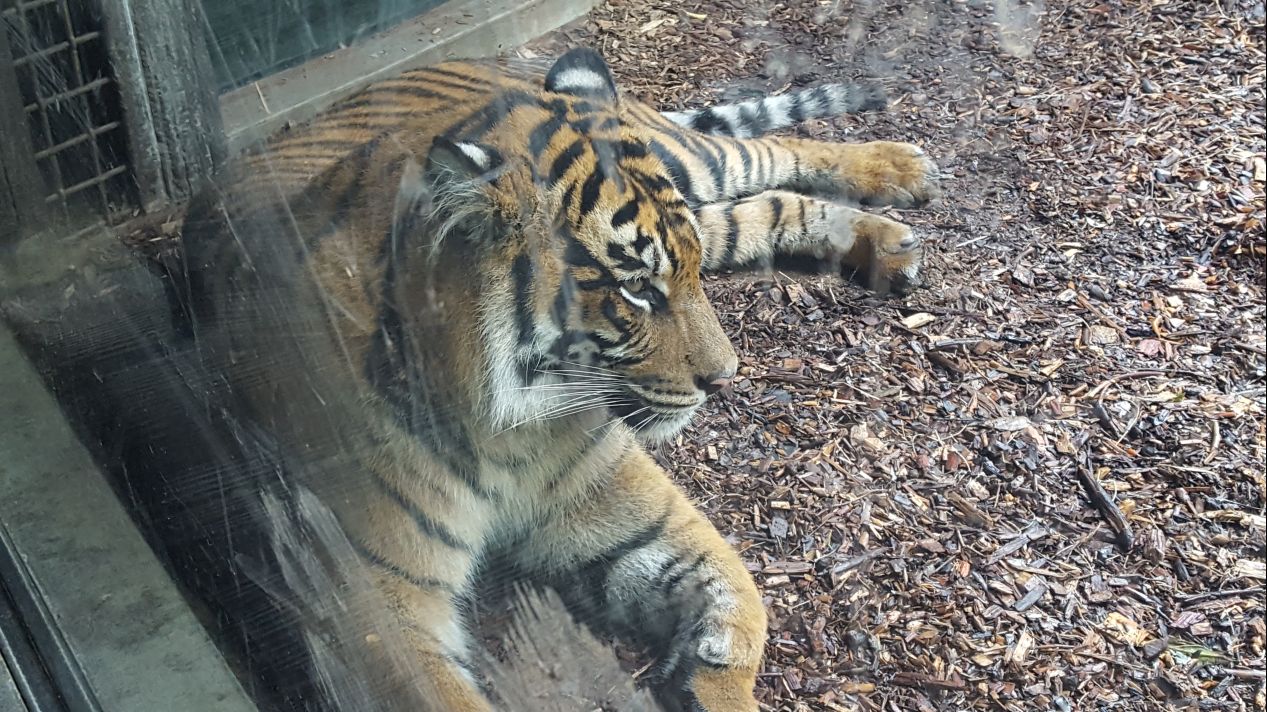


The first place that I went to see was the "Tiger Trail" exhibit. One of the things that sets apart the Safari Park is the sheer number of animals on display; most zoos might have one or two tigers in residence, for example. The Safari Park had a half dozen, separated into several large enclosures and connected together by a walking trail. It had stopped raining for the moment and several of the animals were reclining right up against the viewing glass. The tiger pictured above was right next to the window of the enclosure, no more than a foot away from where I was standing. Without the glass, I could have reached out and touched the animal. And that was only one of the five tigers that I saw in this exhibit! It was incredible and immediately worth the (pricey) cost of admission to the Safari Park, especially with virtually no one else around. I could take a few minutes and watch the animals undisturbed by anyone else.

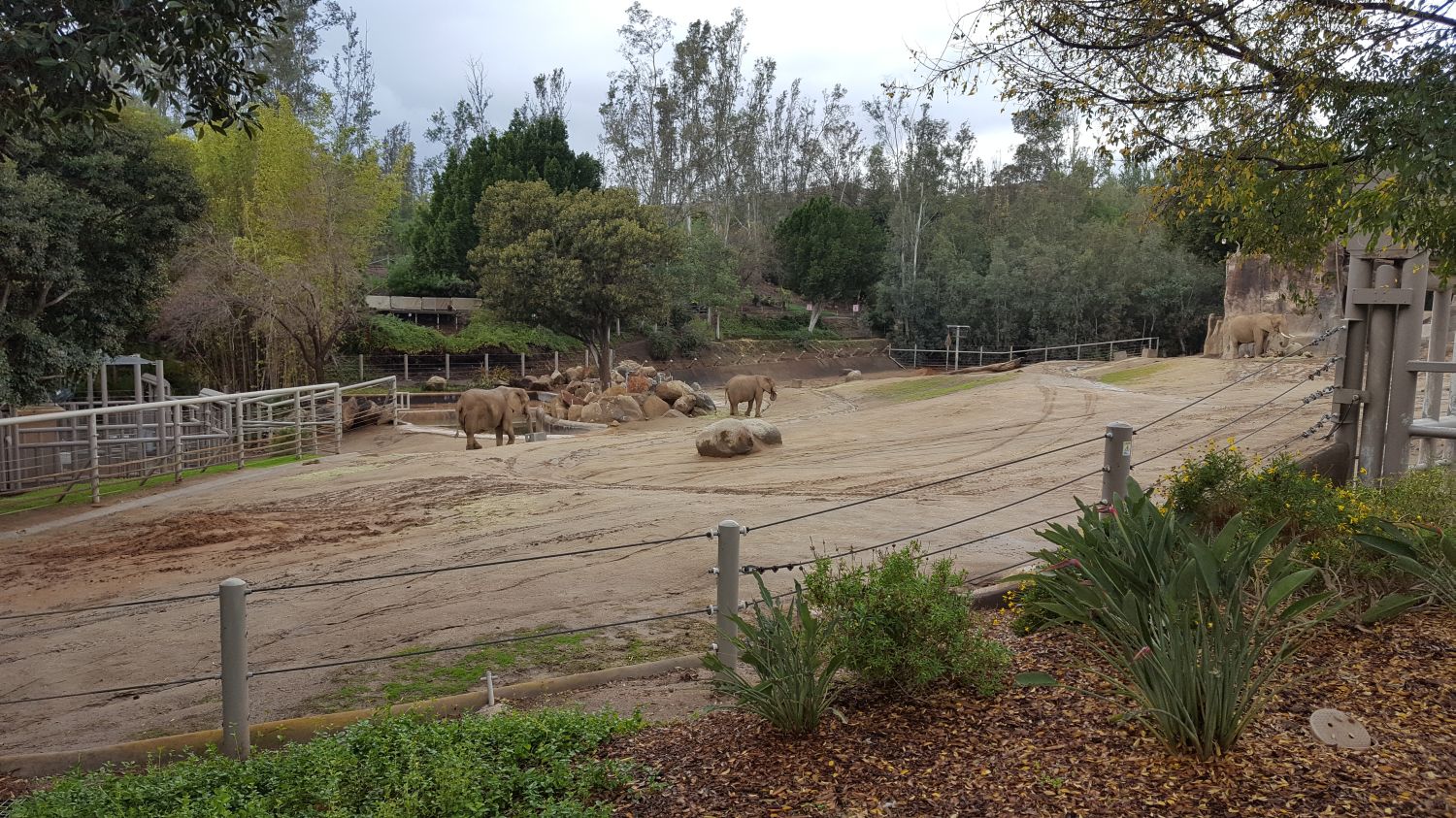


Next I headed over to the elephant section, where the great pachyderms had their own large enclosure. The Safari Park owns about 20 elephants in total and there were five of them outside at the moment wandering around. On a normal day, this place would be packed with visitors to the Safari Park, and there was a stage area with seating for several hundred people where the elephants perform and do tricks. Today it was all empty, with no show times and the seats in the stands soaking wet. I watched the elephants move from one part of their paddock to another through means of an electronic gate that worked similarly to a sliding door at a supermarket. The elephants were smart enough to walk up to the door and wait for it to open when it sensed them, then head over to one of the park trainers who had some food for them to eat. I love these animals and I've been fortunate enough to ride an elephant once, although only for a few minutes at a state fair. (It's a strange experience - their gait is completely different from a horse.) I would have spent more time here, but I had to hurry onwards if I wanted to see anything else.


The reason for my haste was a caravan tour of the safari which was scheduled to depart at 2:45 PM. The caravan tour would take me out into the actual safari portion of the park, the wide open spaces visible above. Most of the Safari Park is taken up by these safari areas where herds of animals move about similar to how they operate in the wild. I was quickly visiting the enclosures of the animals that aren't included out in the safari areas, with the great cats and other predators naturally kept separate from the grazing herds. The weather continued to be changeable as I walked about, raining hard at one point and then giving way to scatterd sunshine ten minutes later. It was a fickle kind of day on that front.

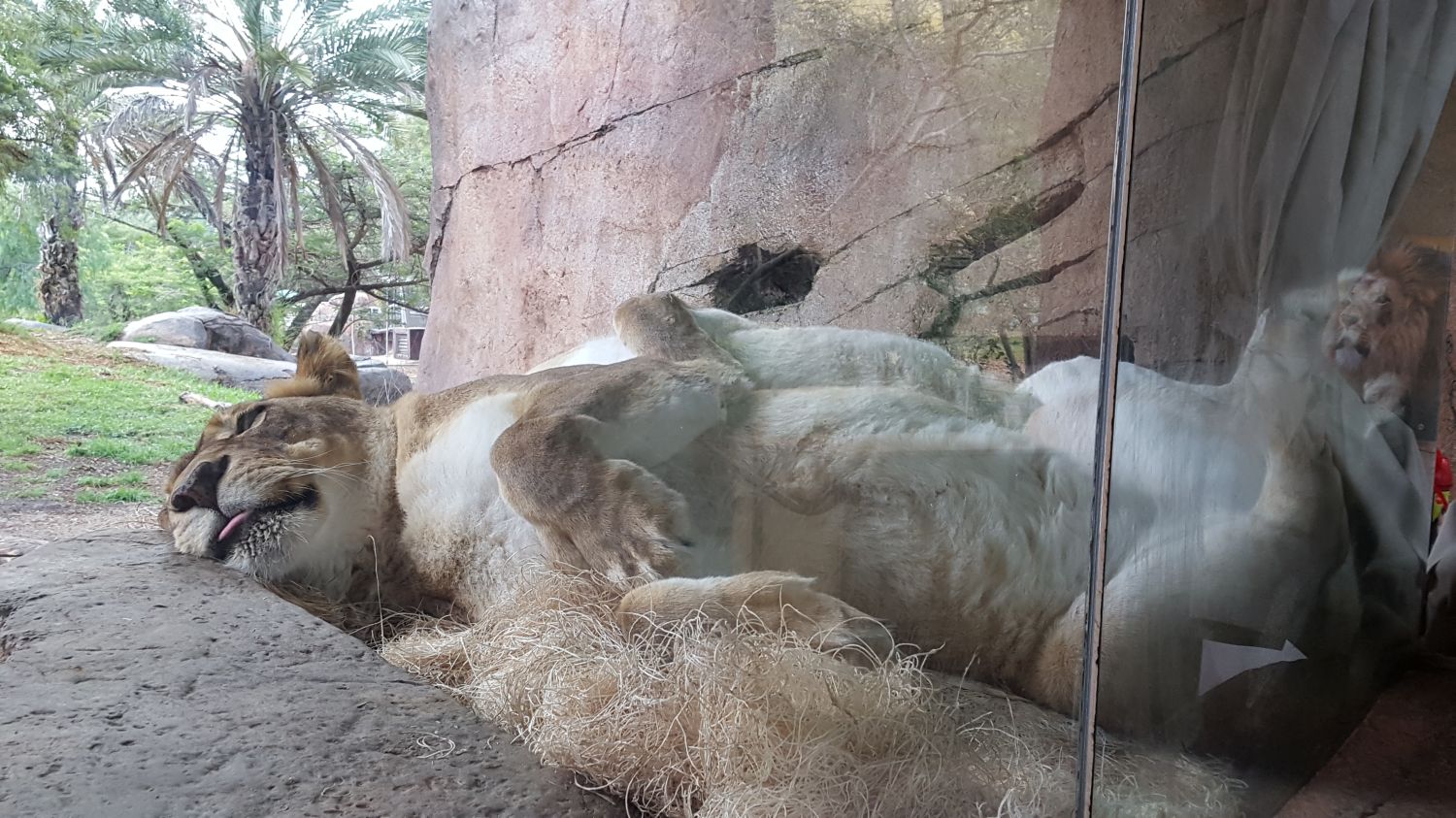


Of course I had to see the lions as well before heading off to the caravan tour. There was a small pride of them in their enclosure, and while none of them were up and about, they were all sleeping right next to the glass. The Safari Park employees craftily put their sleeping area with sawdust right up against the viewing glass to make sure that the animals would be visible while sleeping. I was amused at how the lionesses slept upside-down on their backs, with their paws flopping down to the side in silly fashion. The male lion was reminscient of our dog Sidney, who likes to sleep in exactly the same pose with his head laying on a pillow. I was also able to take this picture:

In case anyone was curious, yes, their paws are about the same size as a human hand.  Just a little bit smaller; I'd say that the male lion probably could have covered my face with his paw. These are absolutely amazing creatures to watch, and their mannerisms are surprisingly similar to house cats. One of my favorite things about tigers is that they view humans as prey and are very willing to hunt and eat us. (Lions are much more willing to leave humans alone.) They literally don't care about us, they think they're superior and are perfectly willing to kill people and eat them for food. Based on my experience with house cats, I think a lot of them would act the same way if they were that big.
Just a little bit smaller; I'd say that the male lion probably could have covered my face with his paw. These are absolutely amazing creatures to watch, and their mannerisms are surprisingly similar to house cats. One of my favorite things about tigers is that they view humans as prey and are very willing to hunt and eat us. (Lions are much more willing to leave humans alone.) They literally don't care about us, they think they're superior and are perfectly willing to kill people and eat them for food. Based on my experience with house cats, I think a lot of them would act the same way if they were that big.

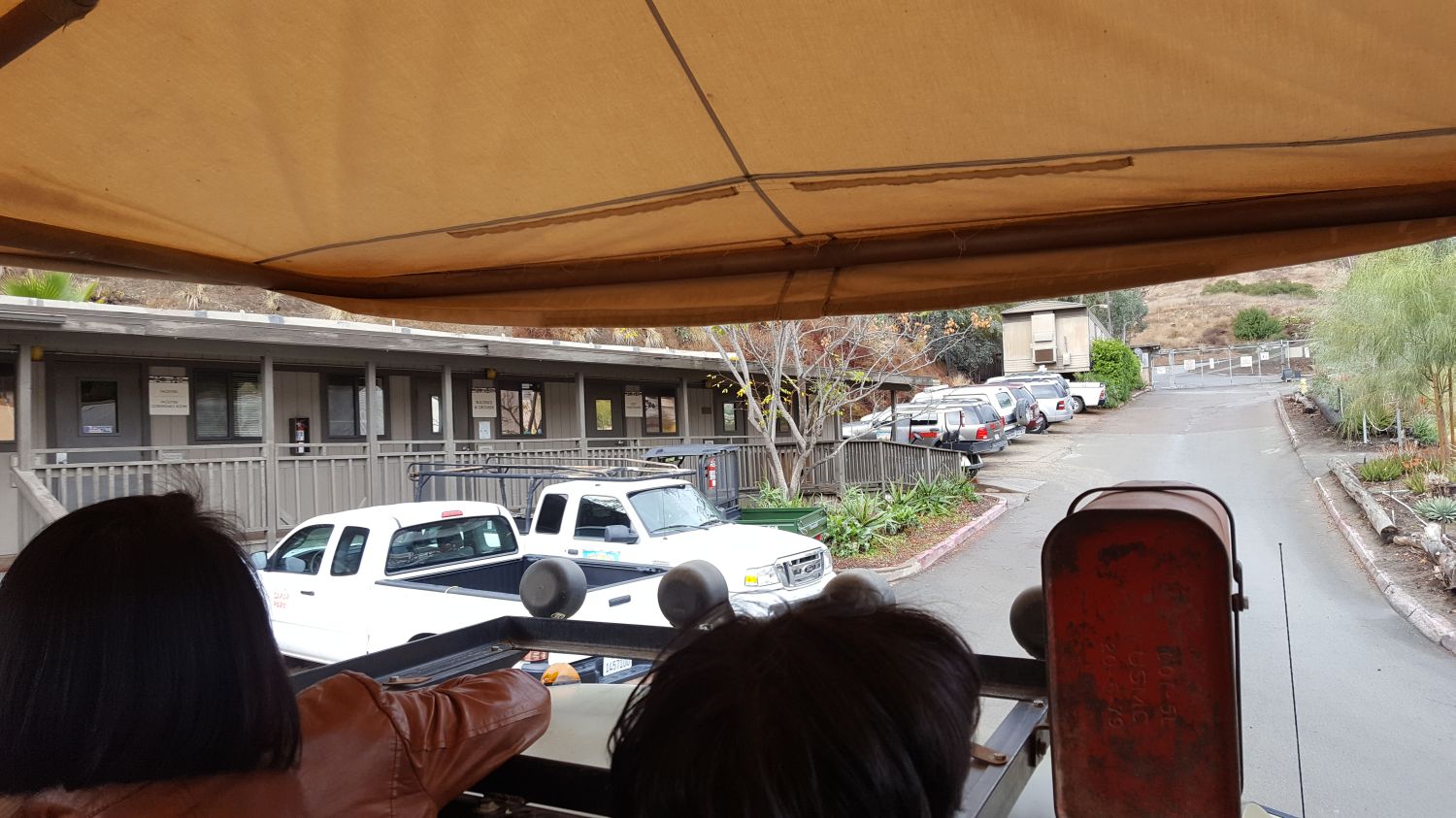


That was the last animal enclosure that I had time to visit before needing to head over to the caravan tour. There's a cheetah racing demonstration that takes place at the Safari Park that I would have loved to see, but it wasn't even happening on this day due to the poor weather. The caravan tour is not included in the cost of admission to the park, and this two hour trip that I had booked in advance was running me another 120 dollars (in 2018 pricing). It was worth the expense, however; how often do you get the chance to drive right up to herds of exotic animals in a natural environment? There were only ten other people on this caravan tour, all of them part of a group from Boston that worked for a pharmaceutical company. It was the ten of them and then me by myself, so I stood out a bit from the rest of the tour group. Our tour guide had been doing this job for many years and had a very laid-back approach, answering questions as asked but otherwise mostly getting out of the way and letting everyone enjoy themselves. Our vehicle drove through a series of gates out into the safari area, which let to several comments about how this felt like entering Jurassic Park... only to hear from the tour guide that Steven Spielberg and some of the other producers had come to the Safari Park while making the film and based a lot of what was in the movie on how things operated here. In other words, this legitimately was like going through the gates at Jurassic Park, they drew inspiration from this place!

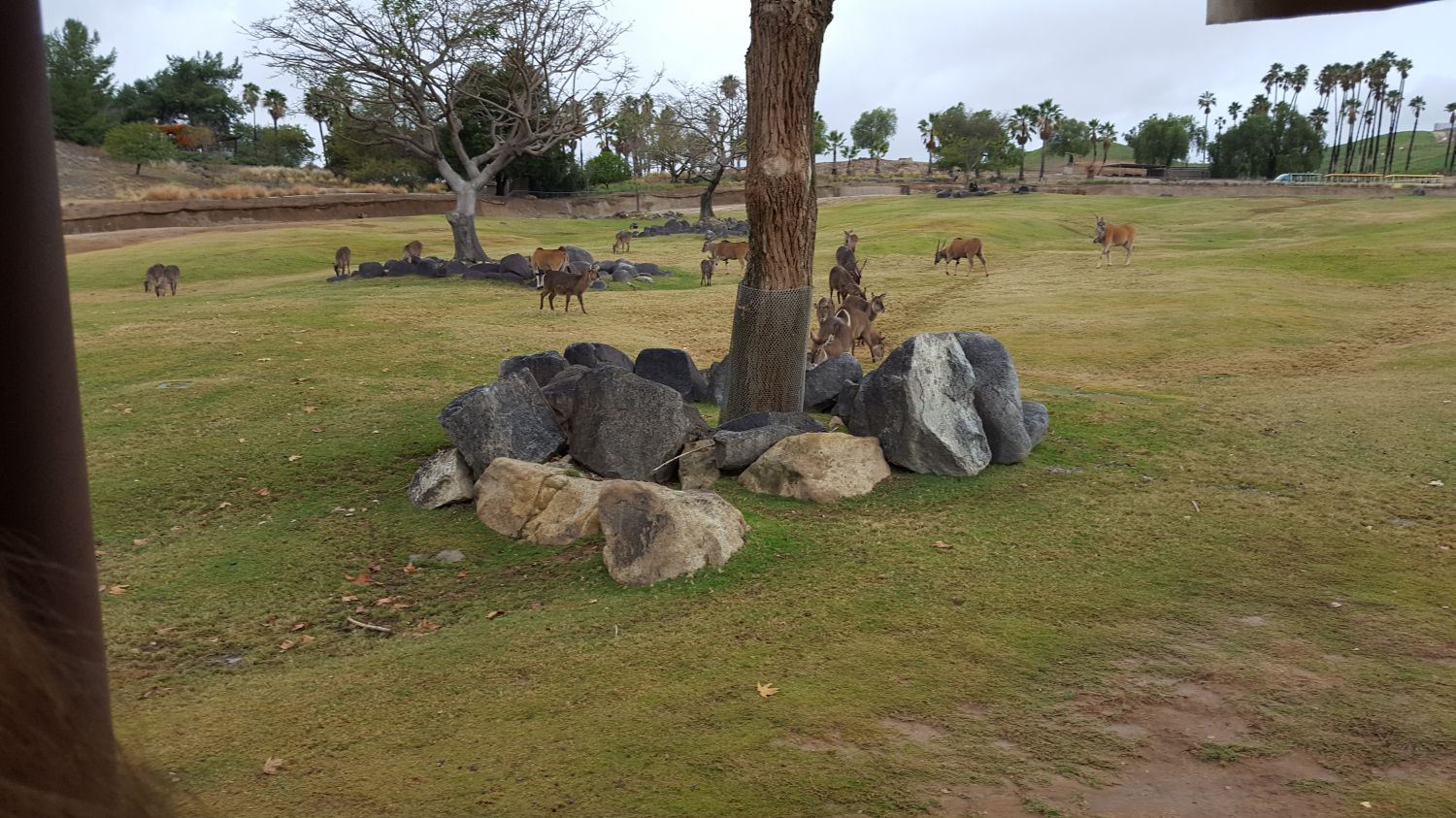


Our vehicle was driving into the African Plains section of the Safari Park first. The animals were used to the caravans driving through and didn't have much of a reaction to our vehicle passing. They would move away if the car came too close but otherwise ignored our presence. It was breathtaking just how many animals were out on the safari, hundreds in all and dozens of them grazing along the sides of the dirt road. I'm afraid that I don't recall the names of all these species, but I believe that these were different types of antelopes. The smaller animals in the last picture were springboks, best known for being the national animal of South Africa and the mascot of their rugby teams. The springboks in paticular didn't seem to be bothered by the vehicle as it drove by and went right on eating the short grass.

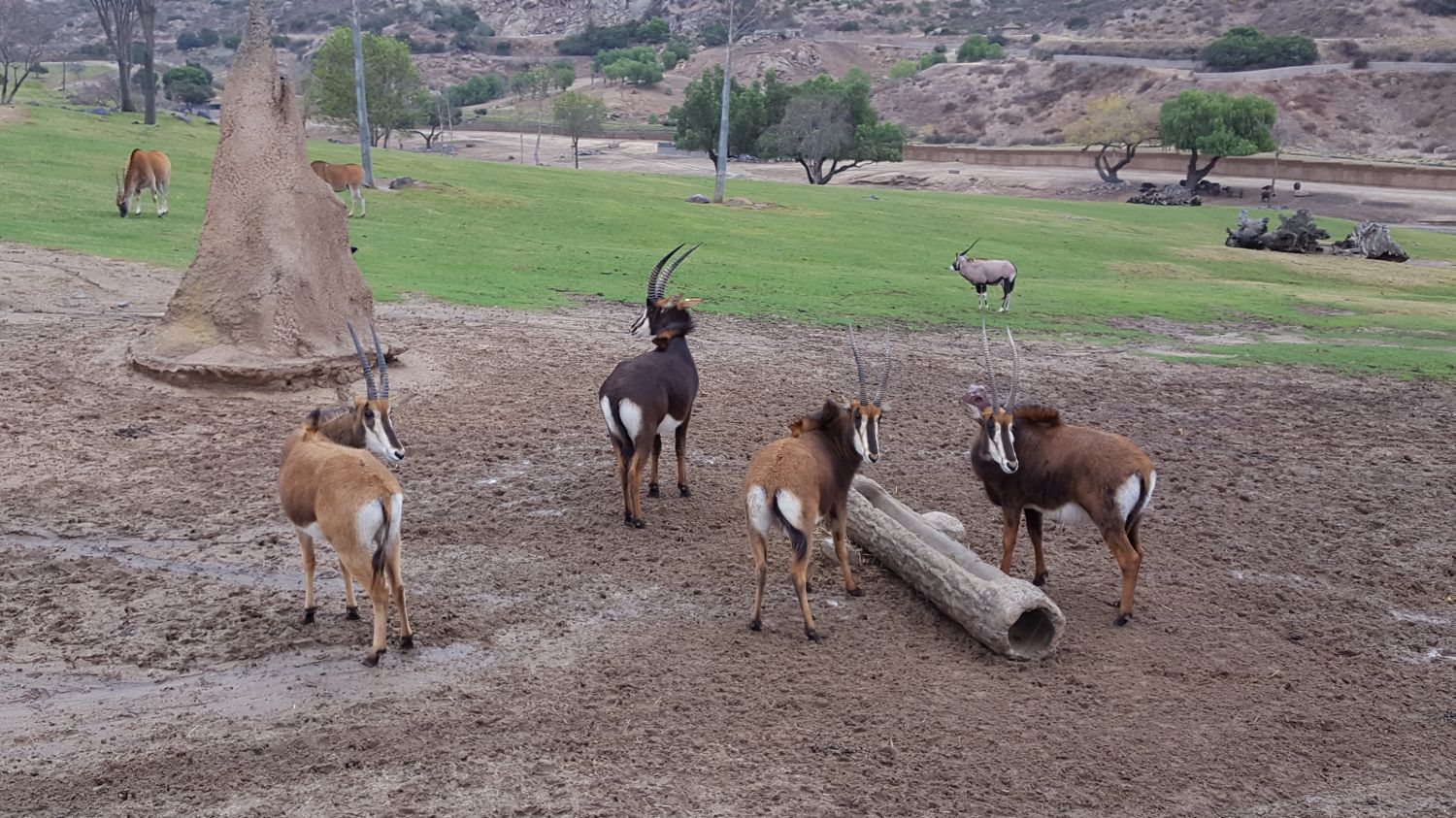


As the tour continued, what had started out as scattered showers was increasingly turning into a driving downpour. Most of the animals didn't seem to care, while others sought shelter under trees to get out of the rain. The animals that turned and looked at us as we drove by were a type of gazelle, and they seemed slightly annoyed as we headed past their watering trough. Further off in the distance was a group of cape buffalo, one of the largest animals that we had yet seen. They were not enjoying the rain and did their best to find relief under a pair of trees. The tour guide said that the cape buffalo have a tendency to sometimes charge the caravan vehicles when they get in a bad mood, and it was probably a good thing that they were on the other side of a small stream that was forming out of the rain.


When we reached the outer edge of the African Plains section, our tour arrived at the an area populated mostly by giraffes. There were four of them visible outside, with two adolescent giraffes in a smaller enclosed area and two more adults in the main safari region. Our tour guide pointed out that giraffes don't like the rain and these two were trying to find shelter away from it. Unfortunately they were too tall to fit inside the little building nearby, and they had to content themselves by facing away from the wind. (It was actually a little bit eerie how all of the giraffes were facing the same direction, always away from the wind.) At one point, a giraffe bent down and tried to fit inside the overhanging area but couldn't manage to get inside. Poor things.
There was already a rhinoceros laying on the ground in the back corner of that building. This was apparently the oldest rhino in the Safari Park and likely the oldest one anywhere in the world, topping out at almost 50 years old. Rhinos normally only live to be about 30 in the wild and this particular male rhino had been used in a series of breeding programs with dozens of offspring. Something like 10% of all rhinos in captivity in the world were descendants of this guy. He was quietly resting under the overhang and didn't seem interested in moving.

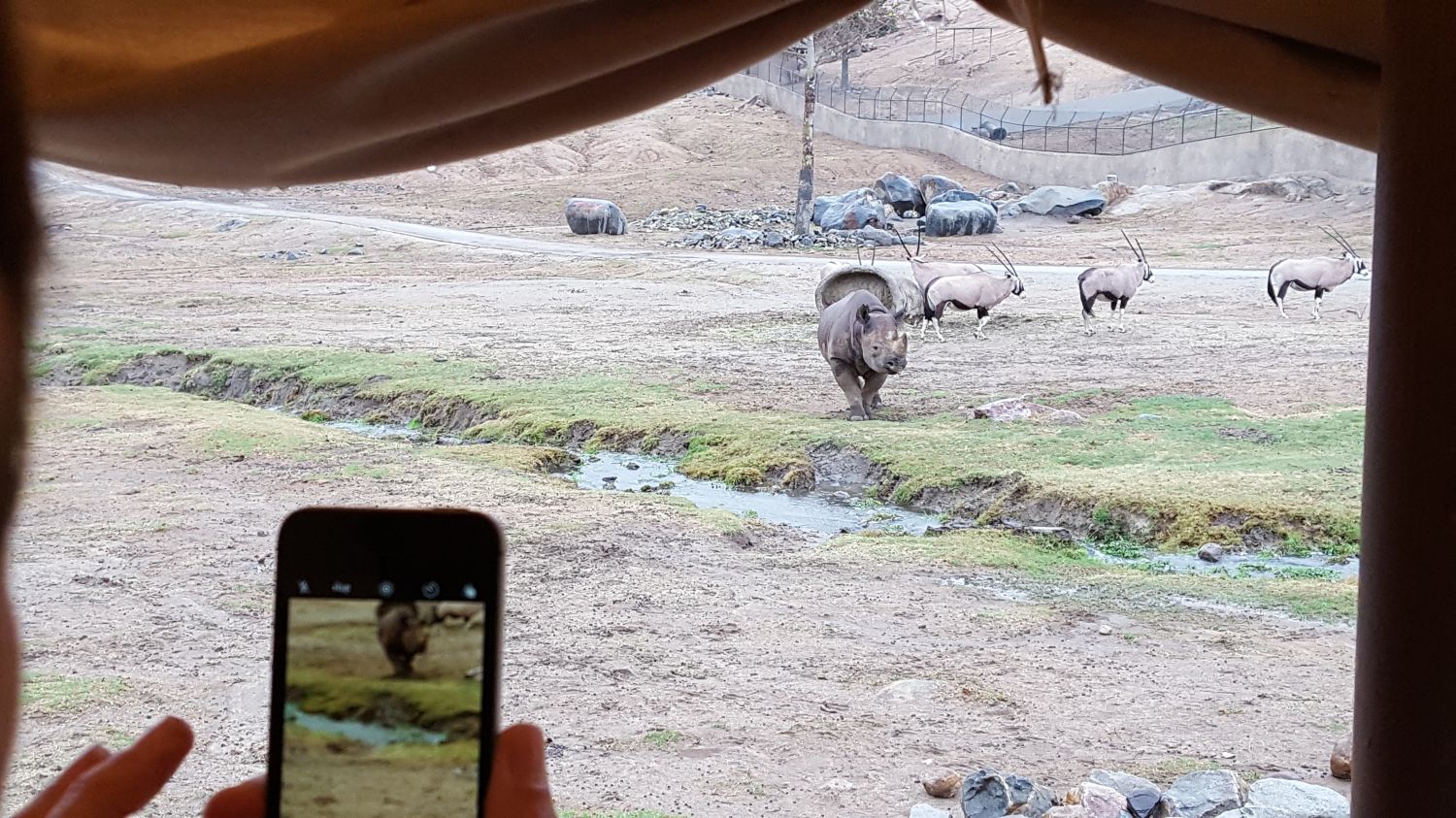


There was another younger rhino who came up and approached our vehicle while we were stopped. This was another male rhino, and he had no hesitation about walking up to the side of the caravan in search of food, which our tour guide did give him. I couldn't believe how close we were able to get to this rhino; I could have reached out and patted the animal on the head if we hadn't been instructed not to do so. I could see the textured patterns in the rhino's skin close up here, and small details like the little furry tufts on his ears. You really get a sense for how large these animals are by seeing them at a distance of a couple feet. This rhino weighted about 1000 kilos, or a little over 2000 pounds, and seemed completely fearless. He even followed after our vehicle for a while when it left, probably hoping to get some more food. The word was that the rhinos also occasionally charge at the caravans; for better or worse, we didn't have anything like that happen.


The tour continued onwards, circling back to the entrance and then heading through another gate into a separate section of the African Plains safari. By now the rain had turned into a torrential deluge, with water pouring down out of the sky in buckets. It was cold and windy in a way that's not at all representative of southern California, even in January. The dirt ground was transforming into a sea of mud with dirty streams of rainwater coursing towards regions of lower elevation. This part of the African Plains had even larger numbers of giraffes present, close to a dozen of them in all, with more adolescent giraffes sticking tightly next to their parents. All of the giraffes looked pretty miserable in the rain, and I regretted that I couldn't have seen them on a better day. It was still astounding just how many of them there were. Most zoos have one or two giraffes, and here I was seeing full herds of them moving around together.

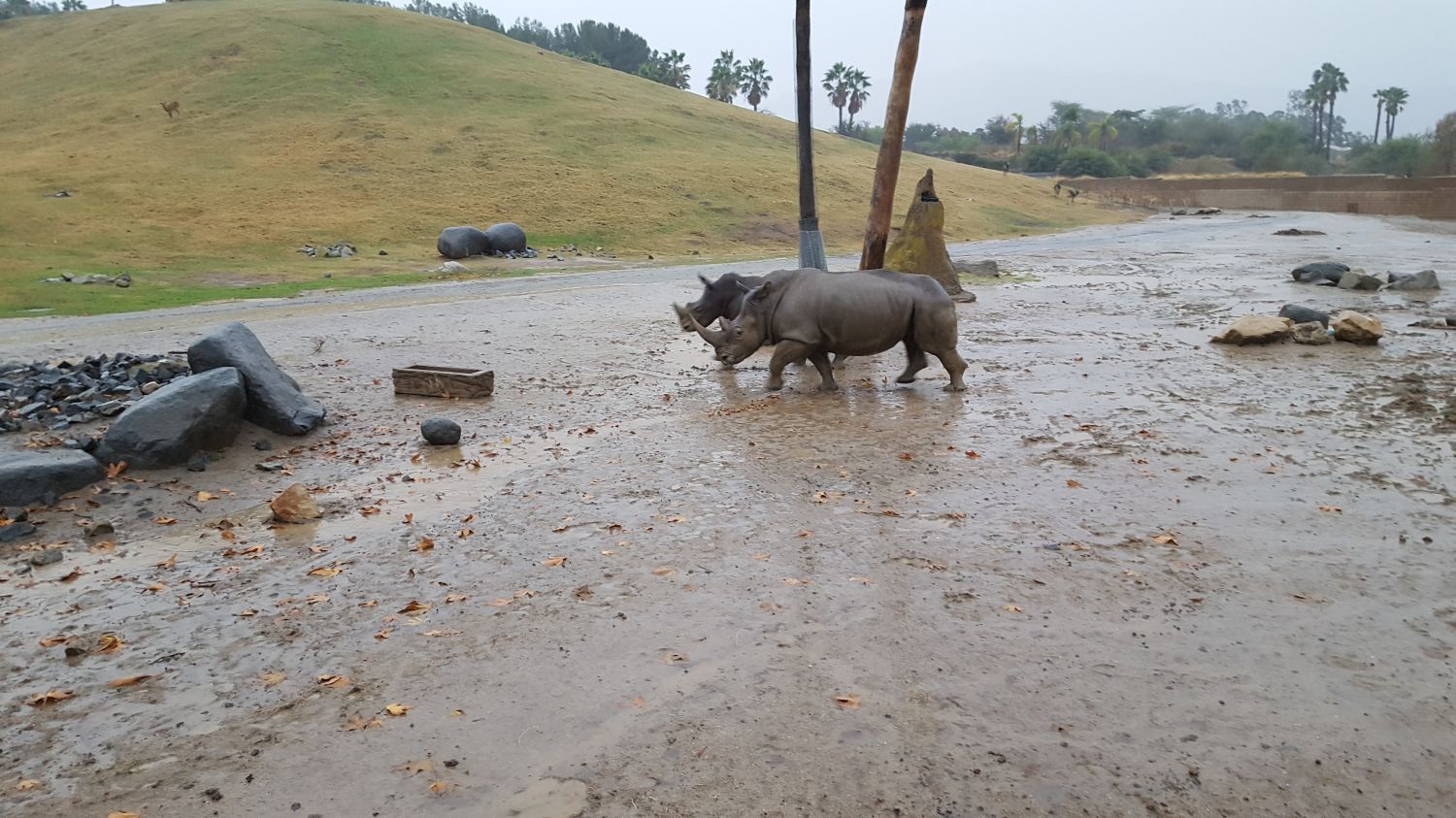


There were more rhinos over here as well, including some adorable baby rhinos that had likely been born the previous spring. They didn't care about the watery conditions at all, and were happy to lay down in one of the pools of water to splash around in the mud. The rhinos had an interesting gait when they moved about, alternating between a lumbering trod while walking that turned into a horselike trot when they decided to move faster. There were both white and black rhinos in the park, and the two differnt types of animal seemed to have no objections to grouping together. All of the open space seemed to make them quite happy even with the weather being what it was. The huge amounts of space are probably the biggest thing that separate the Safari Park from most other zoos. It's impossible to observe animals in a more natural environment at most zoos because they don't have hundreds of acres of land to set aside for roaming.




The highlight of the caravan tour came at the very end, when everyone had the chance to feed the giraffes. They almost had to cancel this due to the pouring rain, but the giraffes were eager to come over and get some food, and those of us on the tour also didn't want to miss the opportunity. I had the first chance to feed one of the giraffes, and that's me in the top two pictures above. I was feeding a docile female giraffe who was very eager to eat the leaves right out of my hand. She clearly was familiar with this drill, happy to crane her neck down into the bed of the caravan for some treats. We were already on a raised platform in the back of the vehicle, and I'd estimate that she was roughly 15 feet (4.5 meters) tall. This was an amazing experience and I wish that everyone had the chance to try something like this.
The other two pictures of the man in the striped shirt were from another person on the tour; I have no idea what his name was. He was feeding the same giraffe only to have a second giraffe come over and insist on joining the whole process as well. It was an even taller male giraffe, and as soon as he showed up he chased away the female giraffe and took the rest of the food for himself. What a jerk. 

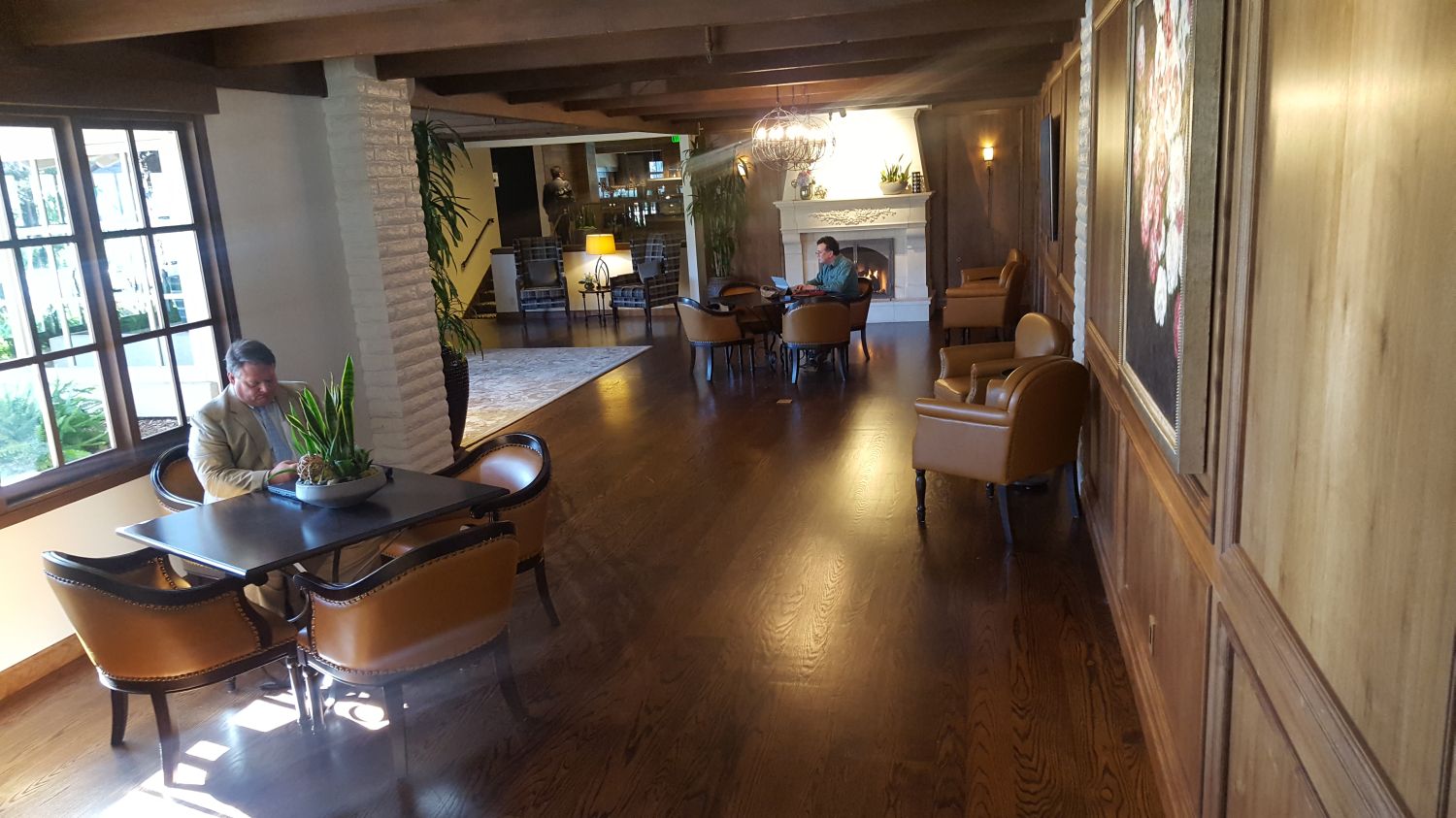


That was the end of the caravan tour. We returned back to the starting point just before the Safari Park closed, and I called another Lyft ride to take me back to the place where I was staying. Here's a few bonus pictures of the Rancho Bernardo inn and conference center from a few days later, when the weather was much better and back to its typical SoCal self. Rancho Bernardo was built in the style of an Italian villa, with lots of low buildings constructed around central green courtyards. There was also a clear influence of Spanish colonial elements of architectural design, with shaded open walkways running from building to building and a central plaza in one spot. It was clear from the way that the inn was designed that it didn't have much cold weather or rain throughout the year, and that first day had been a true outlier. Of course, I didn't have much time to spend wandering around the inn or using the spa facilities, all of which would have cost an arm and a leg anyway. Most of my time on this work trip was spent here:


I was spending about ten hours per day in this big conference room taking part in the AMA meeting. This was a conference between all of the different medical specialty societies in the United States, like the American Urological Association in the above picture, as they met together to make recommendations on the pricing of physician services. Those recommendations were then collected together and sent to my office in Baltimore, where I work with a bunch of other people to come up with the Medicare rates for those same physician services. It's a technical job and it involves a lot of work but I actually enjoy doing it. There's not a lot of other places where someone in their mid 30s would get to have a major role in overseeing $90 billion in federal spending.
Overall, I strongly recommend visiting the San Diego Zoo Safari Park for anyone who might be traveling to the San Diego area, especially for anyone who has a love of animals. It's a hike to get out to the park but easily worth a full day of time. As always, thanks again for reading.



